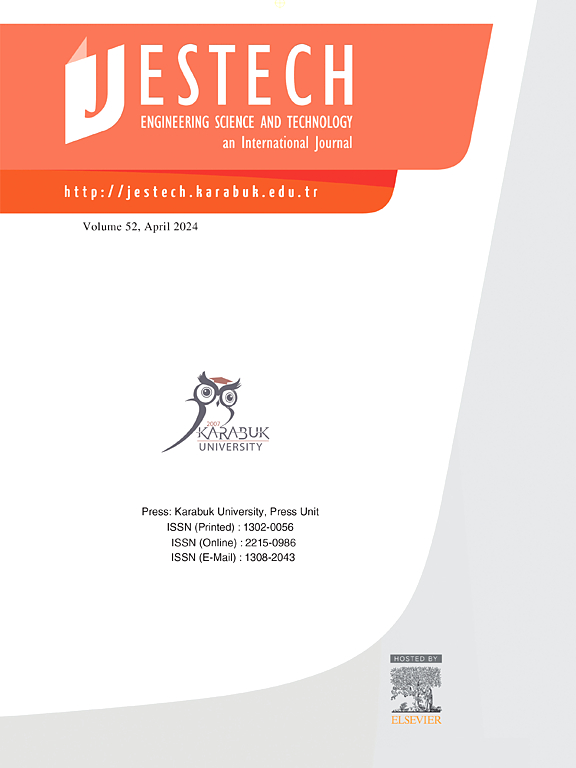Tire aging: A state-of-the-art review
IF 5.4
2区 工程技术
Q1 ENGINEERING, MULTIDISCIPLINARY
Engineering Science and Technology-An International Journal-Jestech
Pub Date : 2025-06-28
DOI:10.1016/j.jestch.2025.102101
引用次数: 0
Abstract
Tire aging is a complex process driven by several environmental and mechanical factors. It significantly impacts vehicle safety and performance, presenting a critical challenge for engineers material scientists. This review paper presents a comprehensive analysis of the key factors affecting the aging of tires (namely oxidation, thermal degradation, ultraviolet (UV) radiation, ozone concentration, and humidity) and examines how each contributes to the loss of mechanical integrity in rubber compounds. Quantitative analyses from the literature show, for instance, that prolonged aging of rubber compounds mainly reduces elongation at break and tensile strength, while modulus and hardness increase. On the tire, these changes lead to an increased risk of failure, reduced traction capabilities, handling issues. For each aging factor, the specific aging mechanism is explored. The review further examines the primary experimental methods used to study the tire aging phenomenon. Particular emphasis is placed on the use of accelerated aging tests and climate chambers. While most studies rely on simplified material specimens, this review highlights the need for methods that better replicate real operational conditions. The paper also addresses the complex synergistic effects arising from the simultaneous action of multiple aging factors, an area that is largely underexplored in the current literature. A major challenge is the definition of accelerated aging test procedures, especially for tires, which involve the combination of mechanical loading and environmental factors. This review bridges fundamental theory of tire aging with practical engineering applications, setting the groundwork for future research in this field.
轮胎老化:最新的回顾
轮胎老化是一个复杂的过程,受多种环境和机械因素的影响。它严重影响车辆的安全性和性能,对工程师和材料科学家提出了严峻的挑战。本文综合分析了影响轮胎老化的关键因素(即氧化、热降解、紫外线辐射、臭氧浓度和湿度),并探讨了每个因素对橡胶化合物机械完整性损失的影响。例如,文献的定量分析表明,橡胶化合物的延长时效主要降低断裂伸长率和抗拉强度,而模量和硬度则增加。在轮胎方面,这些变化会导致故障风险增加,牵引力降低,处理问题。针对每个老化因素,探讨了具体的老化机制。综述了轮胎老化现象研究的主要实验方法。特别强调加速老化试验和气候室的使用。虽然大多数研究依赖于简化的材料标本,但这篇综述强调了更好地复制真实操作条件的方法的必要性。本文还讨论了多种衰老因素同时作用所产生的复杂协同效应,这是目前文献中尚未充分探讨的领域。一个主要的挑战是加速老化测试程序的定义,特别是轮胎,这涉及到机械载荷和环境因素的结合。本文将轮胎老化的基本理论与实际工程应用相结合,为该领域的进一步研究奠定基础。
本文章由计算机程序翻译,如有差异,请以英文原文为准。
求助全文
约1分钟内获得全文
求助全文
来源期刊

Engineering Science and Technology-An International Journal-Jestech
Materials Science-Electronic, Optical and Magnetic Materials
CiteScore
11.20
自引率
3.50%
发文量
153
审稿时长
22 days
期刊介绍:
Engineering Science and Technology, an International Journal (JESTECH) (formerly Technology), a peer-reviewed quarterly engineering journal, publishes both theoretical and experimental high quality papers of permanent interest, not previously published in journals, in the field of engineering and applied science which aims to promote the theory and practice of technology and engineering. In addition to peer-reviewed original research papers, the Editorial Board welcomes original research reports, state-of-the-art reviews and communications in the broadly defined field of engineering science and technology.
The scope of JESTECH includes a wide spectrum of subjects including:
-Electrical/Electronics and Computer Engineering (Biomedical Engineering and Instrumentation; Coding, Cryptography, and Information Protection; Communications, Networks, Mobile Computing and Distributed Systems; Compilers and Operating Systems; Computer Architecture, Parallel Processing, and Dependability; Computer Vision and Robotics; Control Theory; Electromagnetic Waves, Microwave Techniques and Antennas; Embedded Systems; Integrated Circuits, VLSI Design, Testing, and CAD; Microelectromechanical Systems; Microelectronics, and Electronic Devices and Circuits; Power, Energy and Energy Conversion Systems; Signal, Image, and Speech Processing)
-Mechanical and Civil Engineering (Automotive Technologies; Biomechanics; Construction Materials; Design and Manufacturing; Dynamics and Control; Energy Generation, Utilization, Conversion, and Storage; Fluid Mechanics and Hydraulics; Heat and Mass Transfer; Micro-Nano Sciences; Renewable and Sustainable Energy Technologies; Robotics and Mechatronics; Solid Mechanics and Structure; Thermal Sciences)
-Metallurgical and Materials Engineering (Advanced Materials Science; Biomaterials; Ceramic and Inorgnanic Materials; Electronic-Magnetic Materials; Energy and Environment; Materials Characterizastion; Metallurgy; Polymers and Nanocomposites)
 求助内容:
求助内容: 应助结果提醒方式:
应助结果提醒方式:


